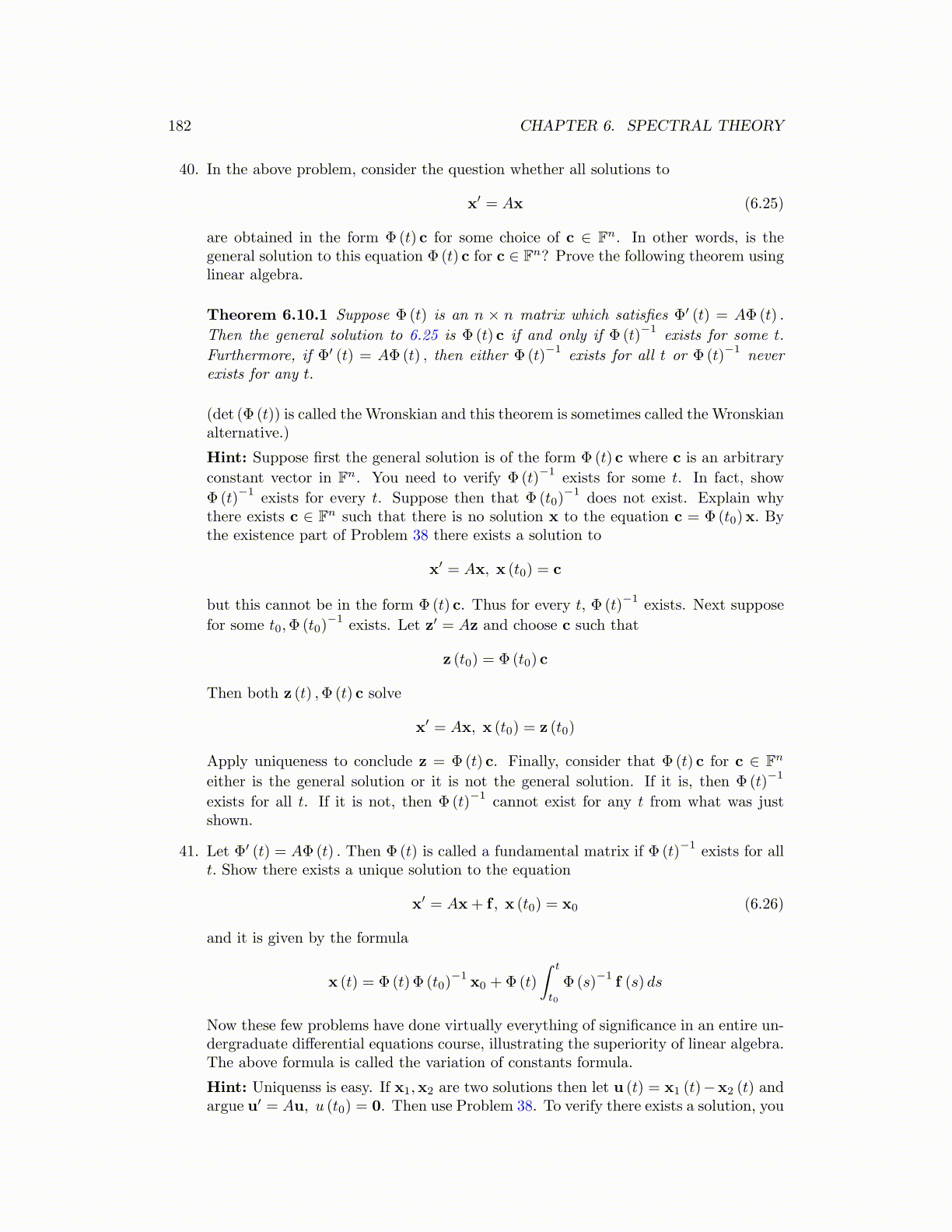
182 CHAPTER 6. SPECTRAL THEORY
40. In the above problem, consider the question whether all solutions to
x′ = Ax (6.25)
are obtained in the form Φ (t) c for some choice of c ∈ Fn. In other words, is thegeneral solution to this equation Φ (t) c for c ∈ Fn? Prove the following theorem usinglinear algebra.
Theorem 6.10.1 Suppose Φ (t) is an n × n matrix which satisfies Φ′ (t) = AΦ (t) .
Then the general solution to 6.25 is Φ (t) c if and only if Φ (t)−1
exists for some t.
Furthermore, if Φ′ (t) = AΦ (t) , then either Φ (t)−1
exists for all t or Φ (t)−1
neverexists for any t.
(det (Φ (t)) is called the Wronskian and this theorem is sometimes called the Wronskianalternative.)
Hint: Suppose first the general solution is of the form Φ (t) c where c is an arbitrary
constant vector in Fn. You need to verify Φ (t)−1
exists for some t. In fact, show
Φ (t)−1
exists for every t. Suppose then that Φ (t0)−1
does not exist. Explain whythere exists c ∈ Fn such that there is no solution x to the equation c = Φ(t0)x. Bythe existence part of Problem 38 there exists a solution to
x′ = Ax, x (t0) = c
but this cannot be in the form Φ (t) c. Thus for every t, Φ (t)−1
exists. Next suppose
for some t0,Φ (t0)−1
exists. Let z′ = Az and choose c such that
z (t0) = Φ (t0) c
Then both z (t) ,Φ (t) c solve
x′ = Ax, x (t0) = z (t0)
Apply uniqueness to conclude z = Φ(t) c. Finally, consider that Φ (t) c for c ∈ Fn
either is the general solution or it is not the general solution. If it is, then Φ (t)−1
exists for all t. If it is not, then Φ (t)−1
cannot exist for any t from what was justshown.
41. Let Φ′ (t) = AΦ (t) . Then Φ (t) is called a fundamental matrix if Φ (t)−1
exists for allt. Show there exists a unique solution to the equation
x′ = Ax+ f , x (t0) = x0 (6.26)
and it is given by the formula
x (t) = Φ (t) Φ (t0)−1
x0 +Φ(t)
∫ t
t0
Φ (s)−1
f (s) ds
Now these few problems have done virtually everything of significance in an entire un-dergraduate differential equations course, illustrating the superiority of linear algebra.The above formula is called the variation of constants formula.
Hint: Uniquenss is easy. If x1,x2 are two solutions then let u (t) = x1 (t)−x2 (t) andargue u′ = Au, u (t0) = 0. Then use Problem 38. To verify there exists a solution, you